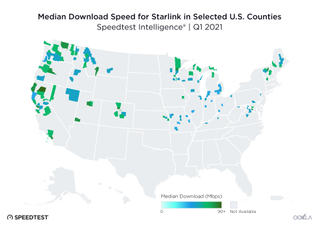
Starlink, Elon Musk's satellite internet company, has reached a major milestone. As of yesterday (May 4), the company says it's amassed 500,000 $99 pre-orders. Along with the pre-order cost, the service also requires customers to buy a $500 kit, which Starlink is still losing money on.
On the heel of this positive news for Starlink, Ookla Speedtest has also put out a report on what coverage and speed is looking like across the United States for the satellite internet network.
- Starlink review
- These are the best Wi-Fi 6 routers available right now
- Plus: Starlink nearing FCC approval for 4,000 satellites — rivals fear collision risks
"To date, over half a million people have placed an order or put down a deposit for Starlink," said SpaceX operations engineer Siva Bharadvaj during yesterday's launch webcast, as reported by CNBC.
During a Twitter exchange with CNBC reporter Michael Sheetz, Musk confirmed that serving 500,000 users would not be an issue. It's when the service moves past the multi-million mark that greater challenges will arise.
Only limitation is high density of users in urban areas. Most likely, all of the initial 500k will receive service. More of a challenge when we get into the several million user range.May 4, 2021
As for the Starlink service itself, it's still in beta, and service continues to improve as SpaceX launches more satellites into low-Earth (LEO) orbit. While some users have reported major increases in speeds, others have not seen the same gains.
Testing firm Ookla found that users utilizing its Speedtest website have seen varied results based on geolocality. The median download speed ranges from 40.36 Mbps (Columbia County, Oregon) to 93.09 Mbps (Shasta County, California).
Generally, areas North of Seattle are seeing strong download speeds, exceeding 90 Mbps. There are pockets that swing a bit slower, around the 50 Mbps mark. Interestingly, areas in California show strong connections, as indicated in green on the map below.
Sign up to get the BEST of Tom’s Guide direct to your inbox.
Upgrade your life with a daily dose of the biggest tech news, lifestyle hacks and our curated analysis. Be the first to know about cutting-edge gadgets and the hottest deals.

Not all counties are seeing massive improvements to performance. While Tehama County in California saw speeds increase 545.6% over broadband providers, users in Clay County, Missouri saw 67.9% slower speeds.

A major challenge for satellite internet is latency. Because a signal has to travel wirelessly from space, pings are often higher when compared to cable or fiber networks. Starlink aims to remedy this by orbiting its satellite internet megaconstellation as low as the FCC will allow. Actually, the company is likely to get FCC approval to lower its existing satellites to 550 kilometers above the Earth's surface.
Regardless, while plenty of users have posted speedtest results with ping as low as 32ms, that hasn't been the case across the board, according to Ookla.
Starlink latency is 486% higher in the U.S. and 369% higher in Canada. Mariposa Country in California saw latency that was 17.4% lower than other providers, median values were between 31ms to 88ms.
While these numbers don't match the 8ms latency that can be found with fiber and cable connections, a 31ms ping isn't awful. Plus, even hardwired internet can see high pings, such as is the case for Daviess Country in Kentucy, which averages 47ms.
In Canada, latency is higher with Starlink when compared to competitors. Pings in British Columbia were 34ms and a significantly higher 61ms in Saskatchewan.
This all means that Starlink has a ways to go before it can provide true global satellite internet coverage at reliable speeds. While the megaconstellation now has 1,500 satellites orbiting above the Earth's surface, it's still a long while away before reaching its initial 12,000 goal. And even then, Starlink plans to put as many as 42,000 satellites into orbit over the next few decades. But for people who live in rural communities, Starlink continues to offer the best hope for 4K Netflix streaming.
- More: These are the best VPN services out right now
Imad is currently Senior Google and Internet Culture reporter for CNET, but until recently was News Editor at Tom's Guide. Hailing from Texas, Imad started his journalism career in 2013 and has amassed bylines with the New York Times, the Washington Post, ESPN, Wired and Men's Health Magazine, among others. Outside of work, you can find him sitting blankly in front of a Word document trying desperately to write the first pages of a new book.

